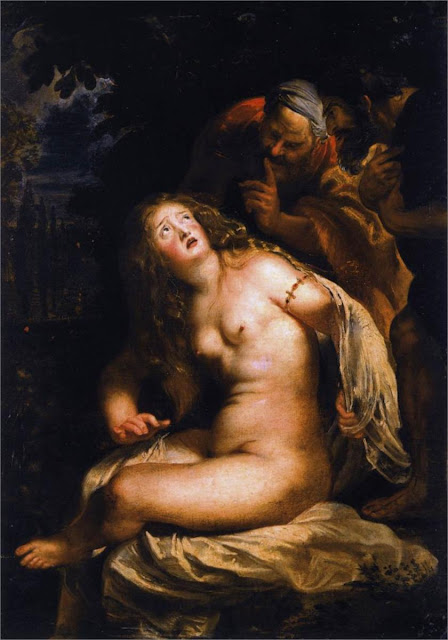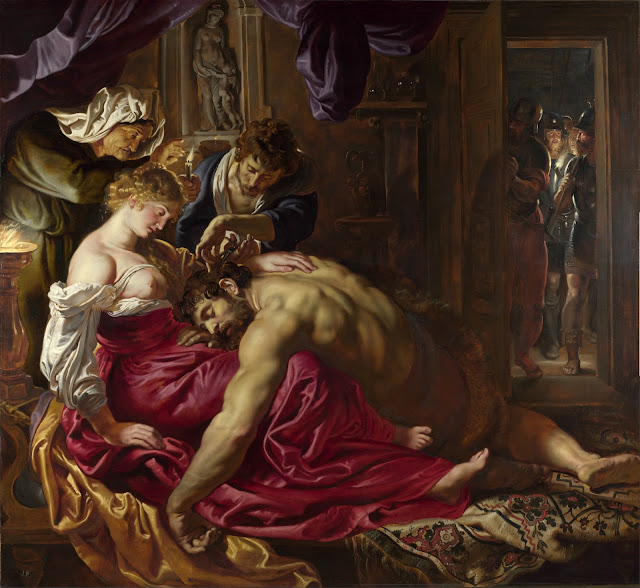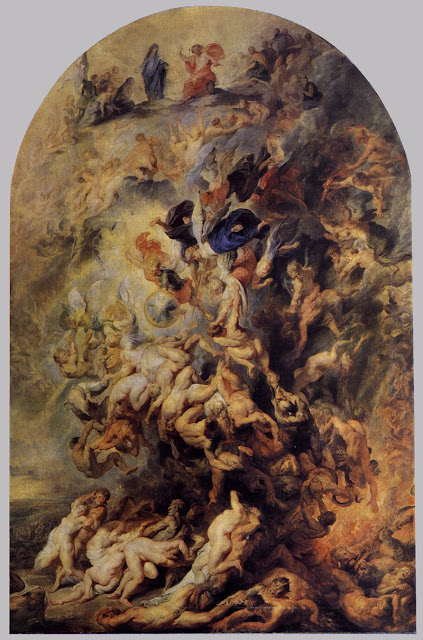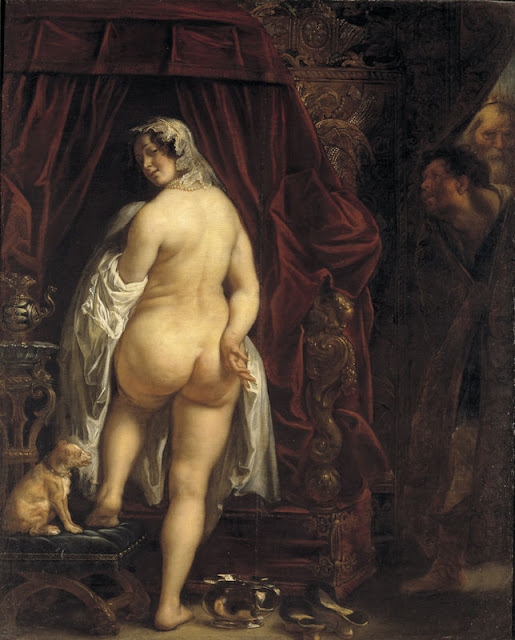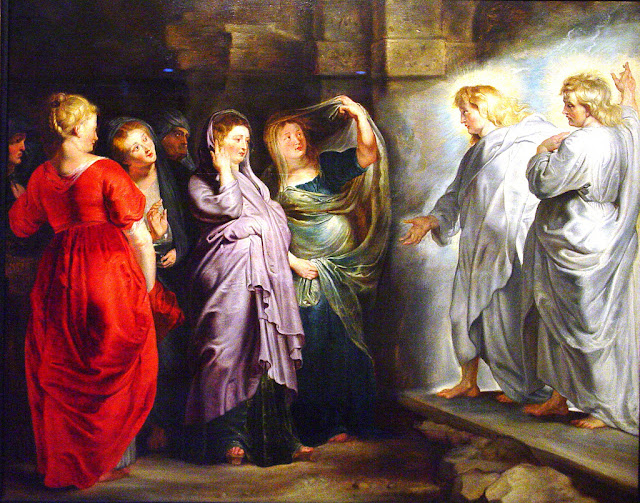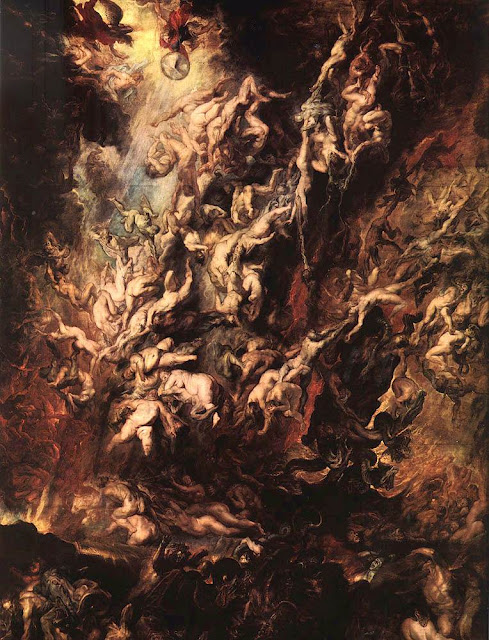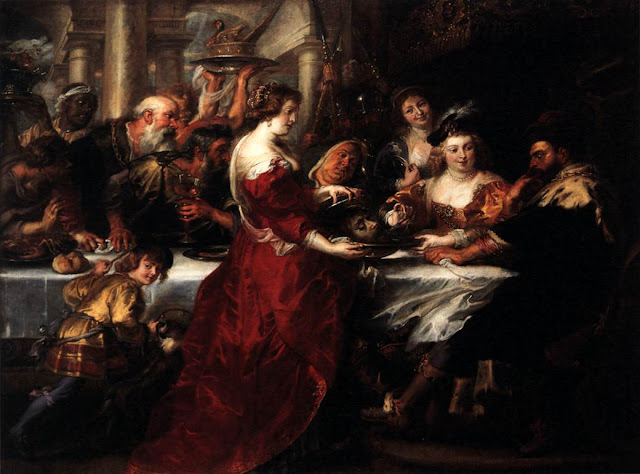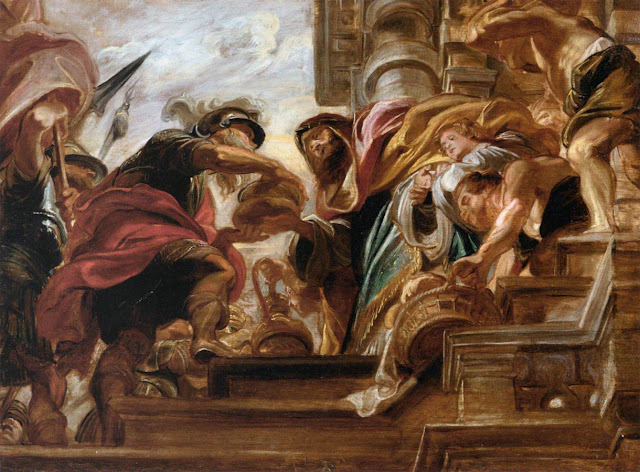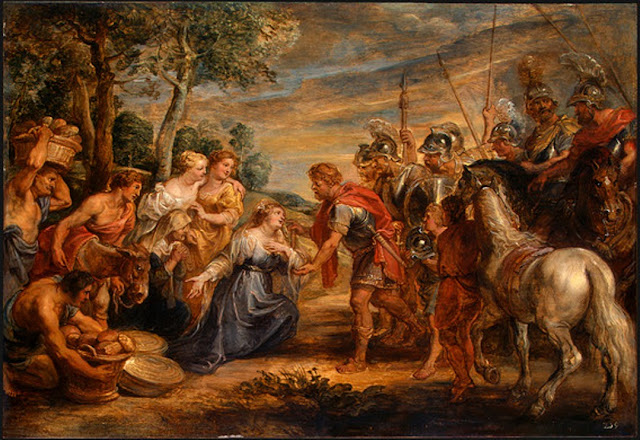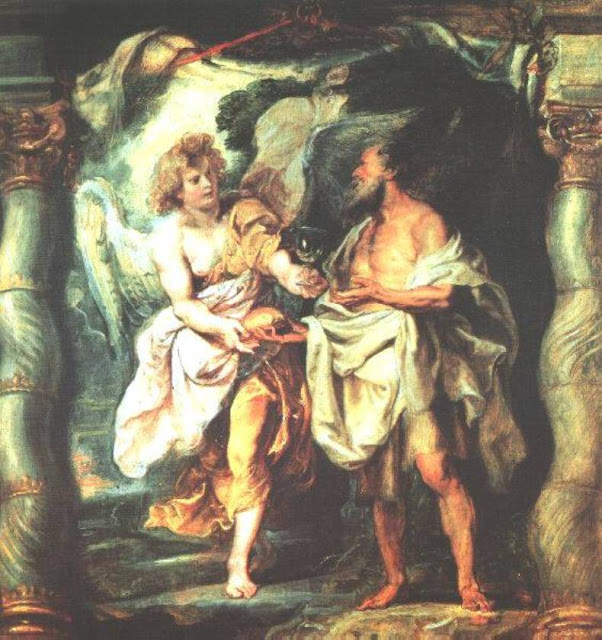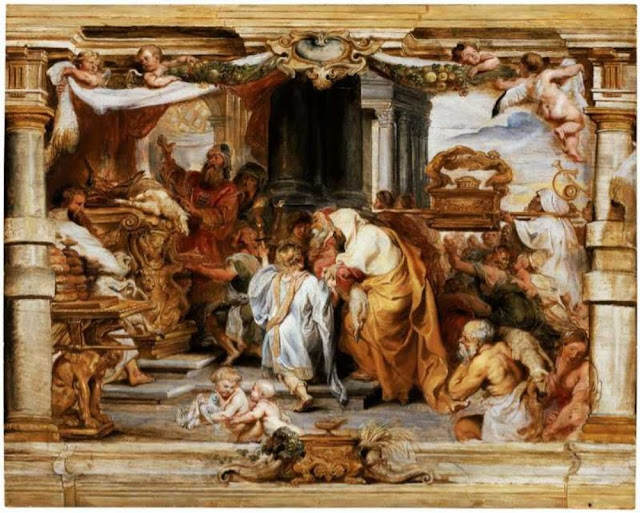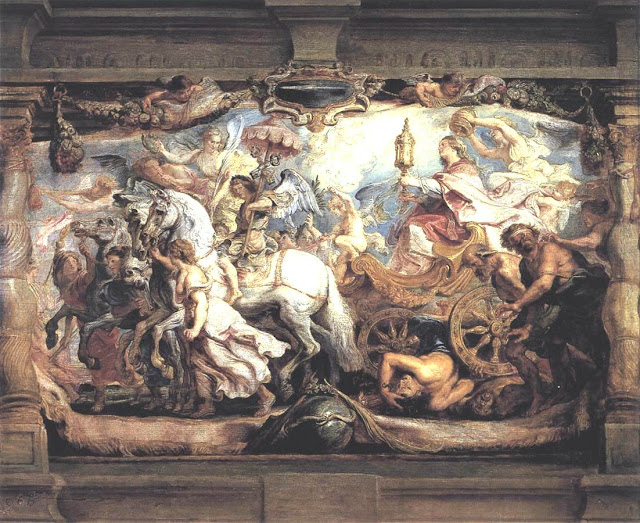Peter Paul Rubens Bible Paintings Part 1
https://phistars.blogspot.com/2012/07/peter-paul-rubens-bible-paintings-part-1.html
Peter Paul Rubens Bible Paintings Part 1
Peter Paul Rubens is the most talented baroque Flemish painter. He painted for Catholic Flanders. In the 1600s, a country was split into Holland and Flanders. Holland became protestant and Flanders stayed Catholic. Despite living in a Catholic country, Rubens was charismatic enough to travel to Holland and learn a few tricks from their realism painters. He also went as far as London and Italy in diplomatic missions. He was a man of the world, as the saying goes. When he died like 20,000 people went to his funeral. Rubens differed from other artist in style and marketing. He is one of the few painters that made financial success during his lifetime. His paintings kept being famous even after he died. Oblivion never closed over the name of Peter Paul Rubens. He was just that awesome.
Well, let us begin with the first painting. Under the influence of Holland, Rubens painted a biblical scene, but in a modern setting. Above, we see the Judgement of Solomon. In the Bible, king Solomon hears a custody dispute between two mothers. One had stolen the baby of the other and traded it for her dead baby. Solomon tested the mothers by ordering his guards to split the baby in half. That way each mother would have a piece of the baby.
In Rubens painting, the soldier is about to cut the baby in half. He is waiting for a cue from king Solomon. The true mother is on her knees begging Solomon to spare the baby. She rather have no child than to see it die. Its interesting the added details of the painting. The true mother, in golden, has before her the dead baby. There is a contrast of colors between the dead baby and the live baby. Well traveled Rubens had the opportunity of seeing plenty of anatomy lessons. He got pretty well acquainted with the human body. You see, this is was the period of the Counter Reformation. To survive, the Catholic church relaxed its rules a bit. They started sponsoring anatomy lessons and public education. They even went as far as saying mass in vernacular tongue. Vernacular means the language of the vulgar.
Part of the Counter Reformation was to engage the vulgar more in the sermons. Thus, they started to commission paintings of biblical scenes, but with a modern look. That way the commoners and the nobles would feel like they are part of the biblical story. Following, this new trend most baroque paintings ended up like this one. Now lets continue with the analysis of this painting.
The young king Solomon is wearing a fancy kingly robe. His red robes are very similar to those worn by the French Sun King. Around him, there are his old advisers looking perplexed. Further in the back, we see the Israelite soldiers in knight armors. Between the legs of the armed soldier there is a dog. In this case, the dog stands for Cerberus. He is eying the dead baby. Behind the lady in white, there is an old hag. She appears to be the midwife. She too is in on the sinister plan of the lady in white. She also represents envy and lies.
Rubens is mostly known for his signature blonde, pink cheeked ladies. You can tell who is the protagonist lady by the color of her hair. Plus, he has her dressed in fancy clothing. In this painting, Rubens has her in a fancy golden dress. Her hair is up to the Flemish fashion. Oh, something else. The white columns in the background are similar to Bernini's Baldacchino. You can find this Baldacchino in St. Peter's Basilica. I think that is everything worth mentioning. In any case, Peter Paul Rubens deserves 5 star rating.
The next painting shows Susana and the Elders. I already mentioned this story in my Artemisia Gentileschi blog. Again, we see the pretty fleshy blondy heroine. One of the elders is taking her clothing while the other is stroking her back. The scenery is more classical. In Susana's toilette there is a Cupid with a dolphin. They symbolize lusty desires. The Elders too are pumped up. Its a mixture of realism and idealism. Its choosing the best of reality. Anyhow, Rubens deserves 5 star rating.
In this version, one of the Elders is telling Susana to keep quiet. The other is putting his hands to his heart. He is trying to convey his desires for her. Both old Leeches are bathed in darkness. The source of light falls straight in Susana's frighten face. This one is closer to the Bible story. Here Rubens placed Susana in a River inside a forest. Its quite dramatic and emotional. Anyhow, this lovely Baroque painting deserves 5 star rating.
In this version, Susana is running away. One of the Elders has grab hold of her garments revealing her hot nude body. Yeah, those Counter Reformation priest were playing hard ball to defeat the Protestants. In this scene, she is inside a fountain in the middle of the forest. Its not unusual for Rubens to have shallow backgrounds. It keeps us focused on the scene taking place at the foreground. Anyhow, this painting deserves 5 star rating.
The next painting is called "The Four Evangelist". These are the writers of the New Testament Books that pertain to the life of Jesus. They are Mathew, Mark, Luke and John. Mark is the old guy. It is was well known that Mark was the oldest of all the New Testament Books. Mathew and Luke are in the Middle. They are placed together because they have the most things in common. Standing apart from the lot is John, in red. He is the odd ball of the gang. His book started with rantings about logos. He also defined the concept of the Trinity and wrote Revelations. He was also the youngest of all the Evangelist. Since these writings are said to have been divinely inspired, there is an angel among them. This angel is telling them of Jesus. The educated church fathers were aware that the first writings about Jesus only came about 30 years after his death.
What's strange is that John is getting his info from an Eagle. The eagle is the symbol of Zeus. Many of his concepts had a Greek flavor to them. He was more concerned about the spiritual nature of Jesus. So while Mark, Mathew and Luke explained who was Jesus, John explained what was Jesus. If you think about it, his introduction to his book was like the Genesis of the New Testament. Its interesting food for thought, if nothing else. You know, I just noticed that there is a cow and tiger in the scene. I suppose those animals are the symbols of the saints. In any case, these four Evangelist of Rubens deserve 5 star rating.
The next painting is about Samson and Delilah. Samson had a cute girlfriend who betrayed him to the Philistines. For some silver, she begged Samson to tell her his weakness. He eventually yielded because doing it with her was just that awesome. Above, Samson has just exhausted himself. He lies resting on top of the belly of his girlfriend. One of the Philistine is giving him a haircut. The scene has brothel feel about it. The old hag with the young Delilah alludes to the sudden rise of brothels all over Europe. They where being financed by the church to combat Sodomy. And they say the Catholics are a bunch of stiffs... Hahahahaha!!
Anyhow, Rubens has given a lot of tension to this scene. If Samson wakes up everyone in the room dies. Delilah has her eyes fixed on Samson. She most certainly will be the first person he kills if he wakes up. Behind the open door, the Philistine guards lie in wait. Behind the candle held by the old hag there is a statue of Cupid and Venus. This alludes to the blind love that Samson held for Delilah. He imagines himself safe in the arms of his beloved. The exposed breasts of Delilah shows the maternal love Samson felt for Delilah. He felt as safe as a newborn babe with Delilah. This painting also alludes to the mythological story of Mars and Venus. Venus tamed war with her love. This shows how man's brute strength is conquered by women's flesh. I think that is everything. Peter Paul Rubens deserves 5 stars for this lovely painting.
The next painting is the last Judgement. This painting is very similar to Michelangelo's "Last Judgement". Bellow, demons are taking people to hell. Around the middle, the worthy are going to heaven. The evil ones are grabbing onto the good people. Meanwhile, the angels and St. Peter are sorting out the Good from the Bad. In heaven, God is judging mankind. The Virgin is advocating on behalf of the first accused. Those found guilty are also cast down to hell. This is why you see God with a hand toward the heaven and the other toward hell. His hand positions is very similar to those held by Socrates and Plato in Rafael's "School of Athens". Those being cast bellow are passing by the angels with the trumpets. These angels are breaking forth the sealed calamities that will destroy the Earth once and for all. I think that just about covers everything. Peter Paul Rubens gets another 5 stars.
The next painting shows Susana undressing for her bath. Behind the curtains the Elders are watching. She has just turned around to see who is looking at her. Ironically, she is gazing at the viewers. Thus, we too become part of the peeping Tom brigade. This scene takes place in a ladies Toilette. The puppy stands for puppy lusty desire. Everything about this scene takes place in Flanders. The ornaments are extremely rich. Rubens was also pals with Diego Velazquez. He probably saw his Rockery Venus. Thus, this Susana is shown from behind. Its unusual to show this angle of a female nude. Anyhow, lets just keep moving right along. This painting deserves 5 star rating.
The next painting shows Lot leaving Sodom. The story goes that Abram pleaded on behalf of this city. The angels would not destroy if they found at least 10 righteous. The only righteous that the angels found where Lot, his wife and three daughters. Before they destroyed the city, the angels told Lot to escape. Here poor Lot is being urged by the angel not to look back. He must flee and leave everything behind. Some of his daughters are taking some of the clothing and jewelery with them. I think I see a dog by the angel's leg. He is running like hell. Well, animals do sense when danger is coming. Lot really does look like a helpless old man. Most of the people look Baroque except for Lot and the angel. They are wearing classical philosopher Greek attires. The angel looks extremely pretty. His golden hair is to die for. His beauty is 100% idealize. As for the humans, they are more down to earth. Anyhow, Peter Paul Rubens deserves 5 star rating.
When Jesus died, some of his women disciples went to his tomb. They brought incense to perfume his dead body. This was a common practice back during Roman times. When they arrived, they were greeted by two angels. They told the women that Jesus had resurrected. The maidens are like regular Flemish women. The angels ,however, sport the Greek Philosopher look. Their halos are thunderous. The only light in the sepulcher comes from the angels. Their are pumped up. The cave looks 100% realistic. This landscaping techniques were perfected in Holland. Anyhow, this lovely painting deserves 5 star rating.
The next painting shows the fall of the Damned. The only source of light comes from the angels. They are sending the damned to hell. Around them, there are demons with animal faces. Its seriously chaotic. The only figures I recognize is a trio of fat guys. They represent gluttony. This painting is a perfect example of Dynamic baroque. This style is known for dramatic contortions and emotionalism. Anyhow, this painting deserves 5 star rating.
The next painting is the Feast of Herod. At this diner party, Salome is bringing John the Baptist head to Herod. Herod is shocked at such a gruesome sight. All are focused on his head. The servants are black guys. During the baroque period, colonization had become the norm. The Conquistadors had exported some black servants for the rich people of Europe. You know, its interesting the merit expression of the maidens. The only one who looks shocked is Herod. Deserts anyone? This dinner party is similar to a regular dinner party in the real world. The scenery is like a Greek temple. Behind the head, there is a fat woman. She stands for gluttony. Anyhow, this lovely dinner party of Rubens deserves 5 star rating.
The next painting shows Abraham and Melchizedek. The king Melchizedek gave bread and wine to Abraham. In Catholicism, this is the first time the communion is mentioned. This is the prototype that was said that Jesus used in the Last super. Above, the old priest dressed like a Roman Legionnaire is giving Abraham wine. One of his servants is bringing out the bread. This is an illusionist painting. It creates the effect of the roof opening up to reveal another world. Its a pretty interesting concept. Anyhow, this lovely painting deserves 5 star rating.
The next painting is showing the same thing as before. This time Rubens placed the scene inside a painted tapestry. The angels are spreading the tapestry for all the viewers to see. Its being placed over the walls of a painted Greek temple. Abraham is dressed like a king. The basins with wine are quite fancy. Melchizedek and his army has the look of legionaries. Anyhow, Rubens deserves 5 star ratings.
This painting shows the meeting of Abigail and David. David had fallen from King Saul's grace. He was escaping with his troops when he met Abigail. David had previously asked Abigail's husband for supplies. Her evil husband had refused. Fearing that David might decide to take them by force, Abigail brought David supplies. She managed to divert David's vengeful wrath against Abigail's estate. David was charmed by Abigail's wisdom. Her husband never found out of her mediation because he got drunk and died. As soon as David got wind of this, he proposed to Abigail.
In this painting, we see a contrast between manly prowess and female gentleness. Abigail is on her knees begging David to spare her estate. Her servants are bringing supplies to David's army. He is charmed by the maiden and is asking her to rise. The bible makes mention of Abigail's management skills. The Bible mentions how all the servants in the house used to obey her. This goes contrary to the patriarch tendencies of the time. Then again, the husband was a drunkard.
Well, the scene takes place outside. The landscape is vibrant and full of colors. Those horses look really cool. The maidens are Rubensian women. That's the name my art teacher gave them. These women are up to date with the Flemish woman fashion. The male servants are dressed like Greek Philosophers. David's men are wearing roman armors. In any case, this biblical painting deserves 5 star rating.
In the next painting, the prophet Elijah receives bread and water from the angel. This alludes to the future communion sacrament given by Jesus. You may have noticed that the bread and water (or wine) offering keeps appearing throughout the bible. Needless to say, that the communion is the most important part of the mass. Its interesting that this angel has a female breast exposed. This shows the androgynous nature of the heavenly beings. The scene is taking place inside a "tapestry". The borders of the painting are the fancy swirling columns of Bernini's Baldacchino. Elijah is dressed like a Greek Philosopher.
In the Bible, they mention how he used to dress in pelts and a lion cloth. Our modern equivalent, a hobo. No offense. That was his ancient appeal. This scene is taking place inside a cave. It so happens that many prophets find God in the darkest of places. Finding light in darkness. It was said that God manifested himself once in the form of a gentle whisper. It makes sense that in quiet caves one would be able to listen to God better. As a matter of fact, Muhammad, Moses and Elijah discovered God in a Cave. In any case, Peter Paul Rubens' biblical painting deserves 5 star rating.
The next painting shows the sacrifice of the old covenant. In the early days, the Catholics were taking in Jews and gentiles. Paul changed all that. His writings threw the Old Covenant out the window. He said that the Jews had been cut off the New Covenant. He said that they had their chance. However, they had kept messing with the widows and the Orphans. For their misdeeds, they had been cut off the New Covenant.
Above, the Catholic beings are about to sacrifice the Old Covenant. They old man represents all the Jewish values. They are also going to burn him along with the Arc of the Covenant. As a matter of fact, Catholic Emperor Justinian had melted the Arc to make replica of Cleopatra's crown for his wife. I suppose after the veil was torn the Arc lost all of its power.
When Jesus died the veil at the temple was torn in half. This veil separated the vulgar from the sacred power of the arc. If the veil was torn it means that God now dwells with mankind. The separation between the mundane and the profane has ended. With this breakage ended the sacrifices. This is the hidden meaning of this painting. Its basically out with the old, in with the new. As a matter of fact, a little blonde deacon is leading the old Covenant to the fire. Now Isaac will sacrifice his father to God. The roles are inverse. Truly, this Peter Paul Rubens' interpretation of this mystery is 5 star worthy.
In the next painting, the Eucharist is beating up Heresy. Heresy is represented as people coming to sacrifice at a Greek temple. Their little party was interrupted by an angel with the Eucharist. They are all cowering before its light. Further in the darkness of the temple, we see a statue of Zeus and its attendants. This scene occurs inside a tapestry held by cherubs. Heresy also refers to Protestantism. In any case, Ruben's painting deserves 5 star rating.
In the last painting for now, the female personification of the church is trampling over hate,fury and discord. Hate is the guy between the wheels. Discord is the blind guy. Fury is an angry person. The church is receiving the papal crown from an angel. She is holding the Eucharist as her symbol. On top of the white horse rides an angel with the keys of heaven. Besides him, an angel with a palm leaf urges him on. Beside her, soars an angel with trumpeters. The reigns of the horses are being led by a man and a women. You know, the design of these paintings are similar to a tapestry series. Rubens also made paintings to be made into tapestries. He did not make the tapestries. They just simply paid him whenever his design was used. That way he kept making money out of a painting indefinitely. Pretty neat if you ask me. This business sense has earned Peter Paul Rubens 5 star rating.
.


